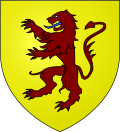House of Mathrafal
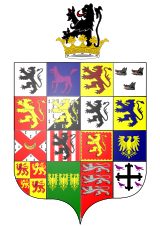
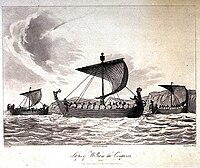

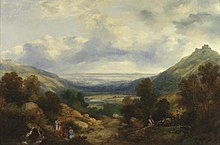
The Royal House of Mathrafal began as a cadet branch of the Welsh Royal House of Dinefwr, taking their name from Mathrafal Castle.[1] They effectively replaced the House of Gwertherion, who had been ruling the Kingdom of Powys since late Roman Britain, through the politically advantageous marriage of an ancestor, Merfyn the Oppressor.[2] King Bleddyn ap Cynfyn would join the resistance of the Anglo-Saxon King Harold Godwinson, against the invasion of William the Conqueror, following the Norman conquest of England. Thereafter, they would struggle with the Plantagenets and the remaining Welsh Royal houses for the control of Wales. Although their fortunes rose and fell over the generations, they are primarily remembered as Kings of Powys and last native Prince of Wales.[3][4]
History[edit]
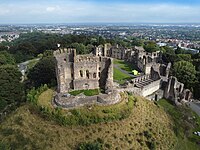
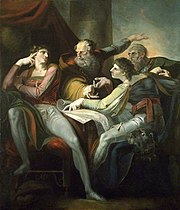
The House of Mathrafal was effectively established in the wake of the Anglo-Saxon King, Harold Godwinson, and his brother, Tostig Godwinson, Earl of Northumbria, and their disastrous raids of 1062–1063 against the King of Wales, Gruffydd ap Llywelyn.[5] They installed Bleddyn ap Cynfyn as King over Powys and Gwynedd and kept him and his base in Mathrafal close to the Saxon border.[6] Mathrafal Castle became their seat and effective capital in Powys, replacing the Roman city of Viroconium.[7]
From this point forward, his family jockeyed with the Royal House of Dinefwr and the Royal House of Aberffraw for the control of Wales. (The unrelated dynasty in the Kingdom of Gwent and the Kingdom of Morgannwg was swiftly overrun by the Marcher Lords after the Norman Conquest).
The House of Mathrafal's influence was greatest between 1063 and 1081, until they lost control of Gwynedd to a resurgent Aberffraw family following the Battle of Mynydd Carn. By 1191, the Kingdom of Powys was divided between the Principality of Powys Fadog in the north and the Principality of Powys Wenwynwyn (roughly modern Montgomeryshire) in the south.[8] The first became a more-or-less loyal vassal of Gwynedd; the latter, one of its main competitors.
Historian John Davies points out that, following the division of Powys, the dynasty should not be considered as "equal" to that of the Royal House of Aberffraw or the Royal House of Dinefwr.[9] Mathrafal Castle was utterly destroyed by Gwynedd in 1212 and thenceforth it was entirely dependent on English support for its survival. However, the Mathrafal dynasty continued to exert some influence, undermining and eventually betraying the Prince of Wales, Llywelyn ap Gruffudd, on behalf of the Plantagenet King, Edward Longshanks, during his Conquest of Wales in 1282–83.[10]
Thereafter, they avoided his campaign of extermination against the Welsh Royal Houses and even exchanged their claims to royalty for an English Lordship at the Parliament of Shrewsbury in 1283.[11] They were displaced by the Lords of Mortimers in the early 14th century, until a momentary reascension of the House during the 15th century, following the Welsh Revolt led by the Prince of Wales, Owain Glyndŵr, against Prince Henry and King Henry IV of England, of the Royal House of Lancaster. Glyndwr combined the claims of the Houses of Mathrafal and Dinefwr, with links to the House of Aberffraw.[12]
Welsh Revolt[edit]
The rebellions were supported by the French Royal House of Valois, and were an attempt not only at gaining the independence of Wales, but also the redivision of England to their relatives, the House of Percy and the Mortimers.[13][14] Despite being crowned as Owain IV of Wales in 1404, and having taking control of all Wales, and having created the first Welsh parliament at Harlech Castle, they eventually lost the war to the English forces of Henry IV and Henry V.[15]
Nonetheless, their efforts didn't go in vain, as their rebellion gave rise to the first Welsh Kings of England, the Royal House of Tudor.[16] The Tudors were their cousins on their mother's side, through the Tudors of Penmynydd, who fought with them during the rebellions, such a Sir Owen Tudor, the second husband of Queen Catherine of France.[17] Glyndŵr was also the wealthiest Welshman in Wales before his downfall in 1415, and captured number of Longshanks’s main castles such as Conwy, Harlech and Beaumaris, and besieged Caernarfon.[18][19]
This historic period would later be immortalized by William Shakespeare in his play Henry IV, Part 1 and Part 2, featuring "Owen Glendower" as a character.[20] The plays depict the wars between his family and Prince Hal, future Henry V, and other historical events. Other characters featured include his daughter, Lady Mortimer, his son-in-law, Sir Edmund Mortimer, and in-laws Henry Hotspur Percy and Lady Percy. The plays were succeeded by "Henry V'" and are part of Shakespeare's Henriad.
Succession[edit]
Vaughans of Corsygedol[edit]
The House was succeeded by the descendants of prince Owain Glyndŵr and his brother, lord Tudur ap Gruffudd, through the Vaughans of Corsygedol in Snowdonia, North Wales.[21][22] The Vaughans would become strong supporters of the Lancasters during the Wars of the Roses, holding Harlech Castle for the Tudors as well as supporting the future Henry VII and his uncle Jasper Tudor, hiding them at Corsygedol during their exile to France.[23][24] After the Tudor victory, they were given positions of power such as Esquire of the Body to Henry Tudor, governor of Cilgerran Castle in Wales, and became one of the official representatives of the Tudor State within the locality under Queen Elizabeth I.[25][24][26][27]
They are today represented by its derivative branches; the House of Yale (Yale family) and the Hughes of Gwerclas, who act as co-representatives of the dynasty.[28][29][30][31][32] They are also the co-representatives of the Sovereign dynasties of North Wales (Gwynedd) and South Wales (Dinefwr), having their genealogies traced back to the Romano-British ruler Cunedda.[33][34][35][36][37] The Vaughans, Yales, and Hughes of Gwerclas, are also cadet branches of the FitzGerald Dynasty through Osborne Fitzgerald, and direct descendants of the Plantagenets.[38][39][40][41] Their ancestor, lord Gerald de Windsor, was an Anglo-Norman, son of the 1st governor of Windsor Castle for William the Conqueror, and ancestor of the current Duke of Leinster in Ireland.[42][43] Notably, he married a Welsh princess named Nesta, daughter of king Rhys ap Tudor, of the House of Dinefwr.
The Wynn baronets, who are today represented by the Williams-Wynns, are related to Mathrafal through the princes of Aberffraw and the Wynne family of Peniarth, and the Jones of Faerdref Uchaf through the Hughes of Gwerclas.[44][45] A descendant, Mary Wynn, daughter of the 4th Baronet, married Robert Bertie, 1st Duke of Ancaster of Grimsthorpe Castle, and passed the Wynnstay Estate to her cousin, Sir John Wynn, 5th Baronet.[46]
Ancestry[edit]
Along with the Royal Houses of Aberffraw, Dinefwr, and Seisyll, the House of Mathrafal traced their descent from King Merfyn the Oppressor who, along with his son, King Rhodri the Great, established control over northern and western Wales.[47][48] Rhodri replaced King Cyngen ap Cadell as ruler of the Kingdom of Powys after the latter died while on a pilgrimage to Rome.[49] His father, Merfyn, had previously allied his family with the last rulers of Powys by marrying Princess Nest, the daughter or sister of King Cyngen.[50][note 1]
In Welsh tradition, her family was of the Royal House of Gwertherion, and had been ruling Powys since the 5th century, through the marriage of an ancestor, Vortigern, the High king, to Sevira, the daughter of the Roman Emperor, Magnus Maximus.[53][54][55] Maximus, a relative of the Imperial Theodosian dynasty, is featured on the Pillar of Eliseg, erected in the lordship of Yale by king Cyngen of Powys (b. 790). Its sub-Roman capital was at Viroconium, a Roman city that been founded by Caesar's Legio XIV Gemina, and abandoned later by Legio XX Valeria, for the fortress at Deva Victrix (Chester) during Roman Britain.[56][57][58]
As a consequence of Merfyn's alliance, King Cyngen's legitimate heirs were either exiled or reduced to the level of minor land owners (e.g., the family of Sir Gruffudd Vychan).[59] Yet, one of the last Kings of Powys, Cadell ap Brochfael, maternal great-grandfather of Bleddyn ap Cynfyn, the first King of the House of Mathrafal, claimed descent from Cyngen's son Aeddan, who seems to have ruled straight after.
Other noble families claimed descent from another of Cyngen's sons, Elisedd, who is mentioned as killing his older brother Gruffydd in the Annales Cambriae. It is therefore likely that Gwynedd's hegemony over Powys was merely propaganda, intended to glorify Gwynedd at the expense of Powys before the time of Prince Owain Gwynedd. Therefore, there was a lot of political instability as the House had to rule two Kingdoms, Powys and Gwynedd.
In the traditional accounts, Rhodri the Great divided his Kingdom among his sons and gave Powys to his youngest, Prince Merfyn. King Cadell in Ceredigion then dispossessed his brother and added Powys to his inheritance.[60] It is possible, however, that Powys remained independent until its 916 annexation by Cadell's son Hywel Dda, who also conquered Dyfed and Gwynedd and established what has become known as the realm of Deheubarth. On the death of Hywel's grandson in 999, Maredudd ab Owain, the realm splintered: Irishmen usurped Gwynedd and falsely passed themselves off as Maredudd's heir in Dyfed. These were removed by King Llywelyn ap Seisyll, from a cadet branch of the Aberffraw line in the commote of Rhuddlan.
In Welsh folklore, Mathrafal, as representative of the House of Gwynedd, claimed descent through the Harleian genealogies from Beli Mawr, an ancestral figure in Welsh royal genealogies, related to Cassivellaunus, a historical Celtic king who led the defence against Julius Caesar during his second invasion of Britain in 54 BC.[61][62][63] In Welsh mythology, starting from Beli Mawr, their genealogies claimed descent in the Welsh Triads and Historia Brittonum, written about 828 by Celtic monk Nennius, from Brutus of Troy, the legendary founder of Britain, descendant of the Trojan hero Aeneas, founder of Rome in Greco-Roman mythology.[64][65]
Members[edit]
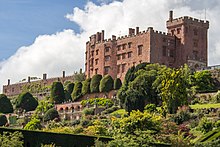
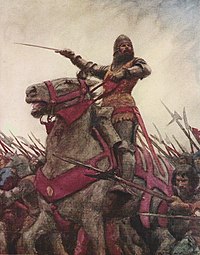
Members of the Mathrafal Dynasty include:[66]
- Bleddyn ap Cynfyn, King of Powys and Gwynedd, joined the Anglo-Saxon resistance with King Harold Godwinson, of the Royal House of Godwin, against William the Conqueror
- Gruffydd ap Llywelyn, King of Wales, son-in-law of Ælfgar, Earl of Mercia, Lady Godiva's son, made an agreement with King Edward the Confessor, of the Royal House of Wessex, his widow remarried the last Anglo-Saxon king Harold Godwinson, who died at Hastings fighting against William the Conqueror
- Rhiwallon ap Cynfyn, King of Powys and Gwynedd, his daughter married the King of Deheubarth, Rhys ap Tewdwr, of the Royal House of Dinefwr, was half-brother of the King of Wales Gruffydd ap Llywelyn
- Trahaearn ap Caradog, King of Gwynedd, fought against the King of the Welsh, Gruffudd ap Cynan, of the Royal House of Aberffraw, and the Norman Lord Robert of Rhuddlan
- Rhiryd ap Bleddyn, King of Powys, killed at war by the King of South Wales, Rhys ap Tewdwr, of the Royal House of Dinefwr, his father King Bleddyn ap Cynfyn was the founder of Mathrafal
- Cadwgan ap Bleddyn, Prince of Powys, married to a member of the House of De Say, companions of William the Conqueror, was an ally of King Gruffudd ap Cynan against the Montgomeries, Norman magnates
- Owain ap Cadwgan, Prince of Powys, he and his father lost lands to King Henry I of England, was known for his abduction of Princess Nest, wife of Gerald de Windsor, of the House of FitzGerald[67]
- Iorwerth ap Bleddyn, Prince of Powys, joined the rebellions of Robert of Bellême, 3rd Earl of Shrewsbury, of the House of Bellême, then betrayed him with Lord William Pantulf
- Maredudd ap Bleddyn, Prince, later King of Powys, made peace with King Henry I of England, of the Royal House of Normandy, is featured in Brut y Tywysogion and retired to Snowdonia
- Gruffydd Fychan ap Iorwerth, Marcher Lord, Knight of Rhodes and Knight of the Order of Saint John of Jerusalem, fought in the Crusades under the Knights Hospitaller, rivals of the Knights Templar, his military order was under the protection of Frederick Barbarossa, Holy Roman Emperor
- Gwladys ferch Rhiwallon, Queen of Deheubarth, and mother of Princess Nesta, who had a son with King Henry I of England, son of William the Conqueror
Last Prince of Powys[edit]
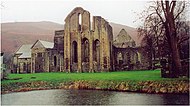
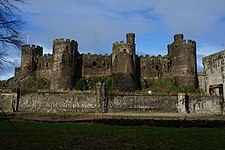
- Madog ap Maredudd, Prince of Powys, fought with Ranulf de Gernon, 4th Earl of Chester of Lincoln Castle, for the Holy Roman Empress Matilda, against the King of England, Stephen of Blois, of the Royal House of Blois
- Gruffydd Maelor I, Prince of Powys Fadog, Lord of Yale, married to Princess Angharad, daughter of the 1st Prince of Wales, Owain Gwynedd, of the Royal House of Aberffraw
- Madog ap Gruffydd Maelor, his son, Prince of Powys Fadog, bore the Black Lion, built the religious center of Valle Crucis Abbey in the lordship of Yale, was grandson of the 1st Prince of Wales, Owain Gwynedd, cousin of Prince Llywelyn ab Iorwerth, and ally of King John Plantagenet of Magna Carta
- Owain Fychan, Lord of Mechain Is Coed, captured Carreghofa Castle, lost it to King Henry II of England, of the Royal House of Angevin, then took it back
- Owain Brogyntyn, Lord of Edeirnion, Lord of Dinmael, of Castle Brogyntyn, confirmed Baron by King Edward Longshanks, of the Royal House of Plantagenet, under the terms of the Statute of Rhuddlan
- Marared ferch Madog, mother of the Prince of North Wales and Lord of Snowdonia, Llywelyn the Great, and was married to Iorwerth ab Owain Gwynedd, of the Royal House of Aberffraw
- Efa ferch Madog, married to the Prince of Maelienydd, Cadwallon ap Madog, the great-grandson of the Prince of Buellt, who founded one of the Five Royal Tribes of Wales
- Gwenllian ferch Madog, daughter of Prince Madog ap Maredudd, ancestress of the Tudors, was married to Lord Rhys, Prince of Wales, who fought and captured many castles of Richard the Lion Heart
- Gwenwynwyn ab Owain Cyfeiliog, Ruler of Mid Wales, made an agreement with King Richard the Lionheart, of the Royal House of Plantagenet
- Gruffydd ap Gwenwynwyn, Welsh King and Prince of Powys Wenwynwyn, married to Hawise, daughter of Marcher Lord John Lestrange, whose father John II joined the Third Crusade against Saladin[68]
- Owen de la Pole, Lord of Powys, family lost their Principality to King Edward Longshanks during his Conquest of Wales, his aunt was Lady Isabella, Queen of Cyprus of the House of Ibelin, and great-great-granddaughter of Balian of Ibelin, who famously defended and surrendered Jerusalem to Saladin
- Hawys Gadarn, mother of Lord Charlton, he was married to a daughter of Roger Mortimer, 1st Earl of March, who was the great-grandson of John of Brienne, King of Jerusalem and Emperor of Constantinople
- Griffith de la Pole, Lord of Powys, was the uncle of Lord Charlton, who was married to a granddaughter of Joan of Lusignan, member of the Royal House of Lusignan
- John Charlton, 3rd Baron Charlton, married to a daughter of the Earl of Stafford, his family included the Duke of Buckingham, Lancaster, Gloucester, and Bavaria of the Royal House of Wittelsbach
- Gruffudd Fychan I, Prince of Powys Faddog, Lord of Yale, Edeirnion and Glyndyfrdwy, great-grandfather of Prince Owain Glyndŵr and Lord Tudor Glendower, lost the Lordship of Bromfield and Yale to the Guardian of Scotland, John de Warenne, the Commander defeated by William Wallace at the Battle of Stirling Bridge[69]
- Gruffudd Fychan II, Prince of Powys Fadog, married to a great-granddaughter of Eleanor Plantagenet, the daughter of King Edward I and Queen Eleanor of Castile of the Royal House of Ivrea[70]
- Eleanor ap Thomas, wife of Prince Gruffudd Fychan II, father was Lord of South Wales, her cousins and in-laws included the Royal houses of Habsburg, Gonzaga, Lorraine, Valois, and Savoy
- Owain Glyndŵr, Prince of Wales, hereditary Prince of Powys Fadog, married to Princess Margaret Hanmer, daughter of Sir David Hanmer, started the Welsh Revolt, was the wealthiest Welshman in Wales[71]
- Tudor Glendower, Lord of Gwyddelwern, brother of the Prince of Wales and cousin of the Tudors, fought against Prince Henry, of the Royal House of Lancaster, during the Welsh Revolt
- Lowry ap Gruffudd, his sister, was married to Robert Puleston, their son held Denbigh Castle for his cousin Jasper Tudor, Duke of Bedford, of the Royal House of Tudor, during the Wars of the Roses
- John Charlton, 4th Baron Charlton, family included Duchess Elizabeth FitzAlan, ancestress of Queen Anne Boleyn, and Beatrice, daughter of King John I of Portugal of the Royal House of Aviz
- Edward Charlton, 5th Baron Charlton, married to Alianore Holland, in-law of Lord Visconti of Milan, niece of King Richard II, great-grandmother of King Edward IV and Richard III, of the Royal House of York
- Maredudd ab Owain Glyndŵr, son of the Prince of Wales, fought in the Welsh Revolt, was later pardoned by King Henry V of England, of the Royal House of Lancaster
- Catrin ferch Owain Glyndŵr, married to Sir Edmund Mortimer, the great-nephew of Edward the Black Prince and Prince John of Gaunt, Duke of Lancaster and richest man in England, was cousin of King Henry IV of England, and great-grandson of King Edward of Windsor and Queen Philippa of Hainault[72]
- Lowrie ap Tudur, heiress of her father Lord Tudor Glendower, and uncle Owain Glyndŵr, Prince of Wales, inherited the co-representation of the Sovereign dynasties of Powys (Mathrafal), North Wales (Gwynedd) and South Wales (Dinefwr), married Griffith ap Einion of the Fitzgerald dynasty of Corsygedol[73]
- Ellis ap Griffith (Elissau ap Gruffudd), her son, Baron of Gwyddelwern, grandson of Lord Tudor Glendower, heir by marriage of Allt Llwyn Dragon (renamed Plas-yn-Yale),[74][75][76] founder of the House of Yale, grandfather of Chancellor Thomas Yale and great-grandfather of Chancellor David Yale, the great-grandfather of Gov. Elihu Yale, benefactor of Yale University[77][78][79][80]
Notes[edit]
- ^ The view that Ethyllt was Merfyn's mother and Nest his wife is held by Davies[51] and many others, including David E. Thornton[50] and Lloyd,[52] who notes the consistency of the genealogies in Jesus College MS 20 from Oxford university and Harleian MS 3859 against the contrary account that Nest was the mother and Ethyllt the wife. Thornton gives Nest as Cadell's sister.[50]
References[edit]
- ^ Ulwencreutz, Lars (2013). The Royal Families in Europe V : A Brief History of the Ruling Houses During The Last 2000 years, From the House of La Tour d'Auvergne to the House of Zähringen, p. 50
- ^ Lloyd, John Edward (1911), A History of Wales from the Earliest Times to the Edwardian Conquest, vol. I (2nd ed.), London: Longmans, Green, and Co (published 1912), p. 323-325
- ^ "RCAHMW: In the steps of Owain Glyndwr". rcahmw.gov.uk. Royal Commission on the ancient and historical monuments of wales. Retrieved 2022-10-31.
- ^ Shakespeare’s Princes of Wales, England’s Hope? Shadowed Heirs in Shakespeare’s Histories, Oxford Academic, Marisa R. Cull, 2014, p.52–82
- ^ Chapter Twenty-One, Wales and West Britain, John Reuben Davis, page 346
- ^ A Companion to Britain in the Early Middle Ages: Britain and Ireland c. 500–1100, edited by Pauline Stafford (Oxford: Blackwell, 2009), pp. 341–357
- ^ Davies, John (1990). History of Wales. Penguin.
- ^ Ulwencreutz's The Royal Families in Europe V, page 50-51
- ^ Davies, John (2007). History of Wales. Penguin Books.
- ^ Chapter Twenty-One, Wales and West Britain, John Reuben Davis
- ^ Ulwencreutz's The Royal Families in Europe V, page 51
- ^ Davies 1990, p. 194.
- ^ Owen Glendower (Owen Glyn Dŵr). By J. E. Lloyd. 9 × 6. Pp. xiv + 161. Oxford: at the Clarendon Press, 1931. 10s. 6d.
- ^ Biography.Wales, Owain Glyndwr (c. 1354 - 1416), 'Prince of Wales'
- ^ Biography.Wales, Owain Glyndwr (c. 1354 - 1416), 'Prince of Wales'
- ^ The History Press, Three things you might not know about Owain Glyndŵr
- ^ The History Press, Three things you might not know about Owain Glyndŵr
- ^ The National Library of Wales, Pennal Letter: Wales’ important role in European politics
- ^ A.D. Carr (1995). "Medieval Wales, British History in Perspective, Chapter 46 : Rebellion and Revenge". Palgrave, London. pp. 108–132. doi:10.1007/978-1-349-23973-3_6.
- ^ Davies 1990, p. 195.
- ^ Burke, Bernard (1852). "A genealogical and heraldic dictionary of the landed gentry of Great Britain & Ireland for 1852". pp. 1662–1663.
- ^ "The Royal Families of England, Scotland, and Wales, with Pedigrees of Royal Descents in Illustration" (PDF). Sir Bernard Burke, C.B., LL.D., Ulster King of Arms. 1876. p. 51.
- ^ Lloyd, Jacob Youde William (1887). "The History of the Princes, the Lords Marcher, and the Ancient Nobility of Powys Fadog, and the Ancient Lords of Arwystli, Cedewen, and Meirionydd". Whiting & Co. pp. 1–4–386–389.
- ^ a b Corsygedol: A Brief History, The Institute for the Study of Welsh Estates, Bangor University, Shaun Evans, 2017, p. 13-14
- ^ Vaughan Family of Wales, B. H. J. Hughes, 1999, p. 12
- ^ Lloyd, Jacob Youde William (1887). "The History of the Princes, the Lords Marcher, and the Ancient Nobility of Powys Fadog, and the Ancient Lords of Arwystli, Cedewen, and Meirionydd". Whiting & Co. pp. 1–4–386–389.
- ^ Davies, W. Ll., (1959). VAUGHAN family of Corsygedol, in the parish of Llanddwywe, Meironnydd. Dictionary of Welsh Biography. Retrieved 3 Nov 2023, from https://biography.wales/article/s-VAUG-COR-1250
- ^ Henry Whittemore (1897). "The Heroes of the American Revolution and their Descendants". The Heroes of the Revolution Publishing Co. p. 112.
- ^ Burke, Bernard (1852). "A genealogical and heraldic dictionary of the landed gentry of Great Britain & Ireland for 1852". pp. 1662–1663.
- ^ Encyclopædia of Heraldry: Or General Armory of England, Scotland, and Ireland, John Burke, 3rd Edition, London, 1844
- ^ Burke, Bernard (1886). "A Genealogical and Heraldic History of the Landed Gentry of Great Britain & Ireland". pp. 2060–2061.
- ^ The History of the State of Rhode Island and Providence Plantations, Biographical, The American Historical Society, New York, 1920, p. 51-52
- ^ The History of the State of Rhode Island and Providence Plantations, Biographical, The American Historical Society, New York, 1920, p. 51-52
- ^ Burke, Bernard (1852). "A genealogical and heraldic dictionary of the landed gentry of Great Britain & Ireland for 1852". pp. 1662–1663.
- ^ David Jones, ‘Wales and the Crown’, 1953, in Epoch and Artist: Selected Writings, ed. Harman Grisewood, London: Faber & Faber, 1959, pp. 41–2.
- ^ Bridging the Breaks: David Jones and the Continuity of Culture, by Jasmine Hunter-Evans
- ^ Henry Whittemore (1897). "The Heroes of the American Revolution and their Descendants". The Heroes of the Revolution Publishing Co. p. 112.
- ^ Burke, Bernard (1852). "A genealogical and heraldic dictionary of the landed gentry of Great Britain & Ireland for 1852". pp. 1662–1663.
- ^ Burke, Bernard (1886). "A Genealogical and Heraldic History of the Landed Gentry of Great Britain & Ireland". pp. 2060–2061.
- ^ Henry Whittemore (1897). "The Heroes of the American Revolution and their Descendants". The Heroes of the Revolution Publishing Co. p. 112.
- ^ Encyclopedia of Connecticut Biography, Genealogical-Memorial, Representative Citizens, The American Historical Society Publishers, 1917. Vol. 7, Chicago, p. 95-96
- ^ Burke, Bernard (1852). "A genealogical and heraldic dictionary of the landed gentry of Great Britain & Ireland for 1852". pp. 1662–1663.
- ^ Philip Yorke (1887). "The royal tribes of Wales; To which is added an account of The fifteen tribes of north Wales. With numerous additions and notes, preface and index". Liverpool I. Foulkes. pp. 16–17.
- ^ "Wynne family, of Peniarth". archives.library.wales. Retrieved 2022-10-24.
- ^ D. JONES (Chemist and Bookseller, Barmouth.) (1863). "The Tourist's and Visitor's Hand-Book and Guide to Harlech, Barmouth, Dolgelley, Towyn ..." pp. 34–35. Retrieved 2022-10-29.
- ^ Roberts, G., (1959). WYNN family, of Gwydir, Caernarfonshire. Dictionary of Welsh Biography. Retrieved 14 Aug 2023, from https://biography.wales/article/s-WYNN-GWY-1300
- ^ Lloyd, John Edward (1911), A History of Wales from the Earliest Times to the Edwardian Conquest, vol. I (2nd ed.), London: Longmans, Green, and Co (published 1912), p. 323-325
- ^ Chapter Twenty-One, Wales and West Britain, John Reuben Davis
- ^ Ulwencreutz's The Royal Families in Europe V, page 50
- ^ a b c Thornton 2004
- ^ Davies 1990:81, A History of Wales
- ^ Lloyd 1911:324, A History of Wales, Vol I
- ^ Bartrum., Peter Clement (1993). A Welsh Classical Dictionary; People In History And Legend Up To About A. D. 1000. The National Library of Wales. ISBN 9780907158738. Retrieved 2022-11-08.
- ^ L. Reno, Frank (2014). Arthurian Figures of History and Legend: A Biographical Dictionary. McFarland. ISBN 978-0-7864-5824-0. Retrieved August 15, 2022.
- ^ Laycock, Stuart (2011). Warlords: The Struggle for Power in Post-Roman Britain. The History Press. ISBN 978-0-7524-7560-8. Retrieved August 15, 2022.
- ^ Assessment of Wroxeter, Shropshire, Roger White and Hal Dalwood
- ^ Oxford Classical Dictionary, Viroconium, Sheppard S. Frere and Martin Millett
- ^ As Told in the Great Hall: The Wargamer's Guide to Dark Age Britain, Martin Hackett
- ^ Ulwencreutz's The Royal Families in Europe V, page 50
- ^ Chapter Twenty-One, Wales and West Britain, John Reuben Davis
- ^ Nicholson, E. Williams B. (1908). "The Dynasty of Cunedag and the 'Harleian Genealogies'". London: Honourable Society of Cymmrodorion. pp. 63–67–105.
- ^ Anscombe, A. (1898), "Indexes to Old-Welsh Genealogies (continuation)", in Stokes, Whitley; Meyer, Kuno (eds.), Archiv für celtische Lexikographie, vol. II, Halle: Max Niemeyer (published 1904), pp. 58-60
- ^ GUY, BEN. “THE PEDIGREES OF THE KINGS OF GWYNEDD.” Medieval Welsh Genealogy: An Introduction and Textual Study, NED-New edition, Boydell & Brewer, 2020, pp. 233–64. JSTOR. Accessed 26 May 2023.
- ^ White, David John (2022). The Matter of Britain: How the Tudors Adapted British Historic Tradition to Legitimise their Dynasty, Graduate Program in History, Queen’s University, Ontario, p. 2-31-32
- ^ Jones, Arthur (1910). The history of Gruffydd ap Cynan; the Welsh text, Publications of the University of Manchester, Historical Series, No. IX, Cornell University Library, p. 34-37
- ^ Ulwencreutz, Lars (30 October 2013). Ulwencreutz's the Royal Families in Europe V. ISBN 9781304581358.
- ^ Brut y tywysogion: Or, The chronicle of the princes A.D. 681–1282 (Great Britain. Public Record Office. Kraus Reprints: 1965, ASIN: B0007JD67I
- ^ Bodleian, MS Ashmole 1120, fo. 174r
- ^ The baronage of England, or, An historical account of the lives and most memorable actions of our English nobility in the Saxons time to the Norman conquest, University of Michigan, Dugdale, William, Sir, 1605-1686.
- ^ "The Royal Families of England, Scotland, and Wales, with Pedigrees of Royal Descents in Illustration" (PDF). Sir Bernard Burke, C.B., LL.D., Ulster King of Arms. 1876. p. 51. Retrieved 2022-10-02.
- ^ A.D. Carr (1995). "Medieval Wales, British History in Perspective, Chapter 46 : Rebellion and Revenge". Palgrave, London. pp. 108–132. doi:10.1007/978-1-349-23973-3_6.
- ^ Goodman, A. (1992). John of Gaunt: The Exercise of Princely Power in Fourteenth-Century Europe (1st ed.). Routledge. https://doi.org/10.4324/9781315844411
- ^ Burke, Bernard (1852). "A genealogical and heraldic dictionary of the landed gentry of Great Britain & Ireland for 1852". pp. 1662–1663.
- ^ Lloyd, Jacob Youde William (1887). "The History of the Princes, the Lords Marcher, and the Ancient Nobility of Powys Fadog: And the Ancient Lords of Arwystli, Cedewen, and Meirionydd". London, T. Richards. pp. 1–4.
- ^ "Archaeologia Cambrensis (1846-1899), Yale, and Chirkland". Welsh Journals - the National Library of Wales. 1877. p. 101.
- ^ Encyclopedia of Connecticut Biography, Genealogical-Memorial, Representative Citizens, The American Historical Society Publishers, 1917. Vol. 7, Chicago, p. 95-96
- ^ Burke, Bernard (1882). "A Genealogical and Heraldic History of the Landed Gentry of Great Britain & Ireland". p. 1806. At the bottom of the page, on the right
- ^ Arthur Herbert Dodd (1959). "YALE family, of Plâs yn Iâl and Plas Grono Wrexham". Dictionary of Welsh Biography.
- ^ Thomas Nicholas (1872). "Annals and Antiquities of the Counties and County Families of Wales". Longmans, Green, Reader, and Co. p. 419.
- ^ The History of the State of Rhode Island and Providence Plantations, Biographical, The American Historical Society, New York, 1920, p. 51-52
- Lewys Dwnn Heraldic Visitations of Wales and Part of the Marches between the years 1586 and 1613
Sources[edit]
- Davies, John (2007). History of Wales. Penguin Books. London
- "MERFYN FRYCH (died 844), king of Gwynedd". Dictionary of Welsh Biography. National Library of Wales.
- Davies, John (1990), A History of Wales (First ed.), London: Penguin Group (published 1993), ISBN 0-7139-9098-8
- Lloyd, John Edward (1911), A History of Wales from the Earliest Times to the Edwardian Conquest, vol. I (2nd ed.), London: Longmans, Green, and Co (published 1912)
- Thornton, David E. (2004), "Merfyn Frych (d. 844)", Oxford Dictionary of National Biography, Oxford University Press
- Jones, Owain (2013), Historical writing in medieval Wales, Bangor University

